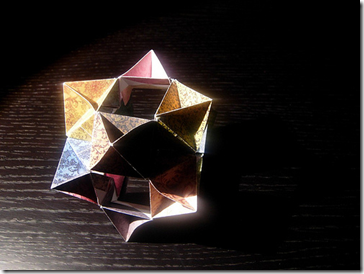 Like transforming paper into origami sculpture requires skill, artistry, material, vision and an idea, transforming invention into innovation requires several elements. The 5 elements are disruption, business model structure, business model infrastructure, adoption, and timing.
Like transforming paper into origami sculpture requires skill, artistry, material, vision and an idea, transforming invention into innovation requires several elements. The 5 elements are disruption, business model structure, business model infrastructure, adoption, and timing.
Recently, there was a discussion on one of the LinkedIn Groups debating whether efficiency was the enemy of innovation. The dialog in that thread with my colleague Kell Sloan, of Nova Scotia led me to identify the 5 elements to transform invention into innovation.
I had made the case that while the words are commonly used interchangeably, invention is not innovation. Innovation is successfully commercialized invention. The key differentiator is commercial viability and success in a market. I’ve written a few posts on this topic and how field of dreams strategies to invent and find a market rarely work.
I owe this post to the discussion there on LinkedIn, and to Kell’s put-your-money-where-your-mouth-is, question: “So, let me ask you, at what point does an improvement in technology or process (invention) become an innovation?”
Transform Invention Into Innovation Example
As a reminder of the differentiation of terms, here’s an example of the difference between invention and innovation that everyone will know. I wrote in the discussion on LinkedIn that Steve Jobs disruptively turned the MP3 player into an innovation by adding iTunes (distribution) and connecting the music industry (content) creating a commercial ecosystem that made the MP3 player itself, commercially viable.
 MP3 players were effectively invented over a decade before, but were not an innovation as they were neither commercially viable, nor successful in any market. I wrote in The Innovation Continuum that Wikipedia lists the first MP3 player as the “Listen Up” player from Audio Highway. Since its introduction at the Consumer Electronics Show in 1997 it has all but slipped into obscurity as a memory.
MP3 players were effectively invented over a decade before, but were not an innovation as they were neither commercially viable, nor successful in any market. I wrote in The Innovation Continuum that Wikipedia lists the first MP3 player as the “Listen Up” player from Audio Highway. Since its introduction at the Consumer Electronics Show in 1997 it has all but slipped into obscurity as a memory.
It Takes 5 Elements
In response to Kell’s question, I identified these five elements in the innovation continuum. I shared that the recipe likely varies from case to case, but the common five elements to transform invention into innovation seem to be unique combinations of the following:
- Disruption – A product, process or service needs to radically disrupt the status quo of the nature that Clayton Christensen defines. If the invention is not interesting, nor does it have unique value and cost differentiation, it’s just an incremental innovation, at best. (Incremental innovation is fine, but uninteresting in the context here. And, it is always a target to be marginalized by true disruptive innovation. One might see the Automotive or transportation industry in general, as an example of annual incremental innovation, readily a target for disruptive innovation like Google’s driverless cars, or Star Trek’s Transporter – Think BIG.)
- Business Model Structure – The invention stands a greater chance for success if it has obvious and immediate value to the buyer (B2B or B2C), and that is often a function of a business model disruption. I haven’t done the math, but I suspect that my kids have spent more for music at $0.99 a song, than I did in college, buying albums on CD for $19.99. The price seems lower, but the business model structure is such that it’s easier to buy more, more often, and feel good about it.
- Business Model Infrastructure – Slightly different than the prior element, this involves leveraging the business model infrastructure available. Think of this as the shift from cash registers to Point of Sale (POS) terminals. Or more recently, the transition from credit cards to the virtual wallet. For most industries (B2B or B2C), it’s the transition to online, not just for retail, but in terms of any and all financial transactions and fair exchange of fees for products and services.
- Adoption – The invention must have been lead with customer-centric design thinking. The kind that only professionally trained marketers can do successfully, efficiently, and at optimal cost and timing. Leading with marketing, especially in the social era, is to surround the invention with marketing as strategy – broad committed effort to gain customer interest, drive market adoption and build industry velocity. The outcome is adoption measured in terms of numbers of users and customers.
- Timing – all of these elements are subject to timing. As products, services, customers and markets create an ecosystem of opportunity; it requires that these elements come together at a common time. They can be driven by a marketing as strategy, approach. Apple does this well. Others come together as industries anchored in legacy let go of the past. Banking, moving toward the virtual wallet is one example. The transition to SaaS and PaaS cloud software for ERP, and other critical back-office systems, is another.
To Ponder
I like ending with To Ponder. It hands over the sparks in my blog to you to ignite into a deeper discussion. While I would like nothing better than to spend a month online, and at the library, researching the points here into a formal PhD dissertation, with statistics, economics examples, and more – I think it’s more effective to push the idea out to you, and ask you for comment and participation.
I respect traditional academic approaches for research and curated new knowledge; but things are starting to move much faster than that. I hope these five elements give your next discussion something to think about.
Side note: Kell Sloan is an interesting individual that is worth the time to get to know. Anyone that has his skills, and catalyzes thought, focuses on customers and builds relationships like he does, is worth having on your team.
I also hope, invite, and request that you please leave a comment. Share with others what ideas you have. Is there a 6th element? What examples do you have that you can add as supporting research?
Image Credits Featured Image Origami: Foglienere via photopin cc, ListenUp Player: WikiMedia Commons.,










Hello,
I found this site by typing-in what I was looking for,
and found precisely what I was looking for …..
Well… the idea anyway .
I’ve realized almost exactly what you have outlined hear several years ago .
The problem is, who orchestrates such an innovation ?
I would imagine that there are at least a few people out there that specialize in
pulling off a coup against the really big players like GM, Ford, Toyota, Honda, the US military, et-al .
I have “re-invented the wheel” by designing a plastic engine that eliminates virtually every single
drawback to the ancient piston engine, including efficiency 3 to 4 times as high,
this includes 3 to 4 times MORE POWER from the same amount of fuel as well .
This is all well and good on paper,
but the damned thing is so stupidly simple, that one glance at it by anyone who knows
anything about engines, and the cat is out of the bag .
I keep wondering if I should just give up before I’ve started and sell-out to the highest bidder .
Jim
Thanks for the comment, Jim. There’s always a path through the political and other agendas in the workplace, for sure. And navigating that will always take careful communication, no doubt. Good luck with this idea – let us know how it goes with a new comment later on as you navigate your path.
Solid list. I like how you are processing here. Timing is critical, so now here is the challenge Andrew: Thanks to a shift in spending certain categories are dying. For example as we spend more money on our smart devices, our smart device plans, the costs associated with consuming information via our smart devices (e.g., magazines, movies), etc. we might spend less money on gardening supplies. So if you are in the gardening business how do you innovate? Ponder that one!